With plans to blast off to the Moon in 2019, Russia have enlisted the help of the European Space Agency (ESA) to provide high-resolution cameras necessary for the landing of the spacecraft as Russia prepares to initiate its new lunar exploration program.
The first mission of Russia's lunar program, Luna-Glob, will be one of five spacecraft that is intended to fly to the Moon to study its south pole from both space and on the ground, with further craft aiming to return lunar soil samples back to Earth with a device also supplied by ESA.
"We hope, at least as of today all agreements have been reached, that the European Space Agency will take part in lunar research," said director general of the NPO Lavochkin research and industrial association, Sergey Lemeshevsky.
"It is quite possible that ESA will take part in the development and manufacture of the high-precision landing systems. It will be the third explorer," said Lemeshevsky.
"We have invited the Europeans to take part, they said ‘yes’ concerning soil collecting devices and ‘yes’ concerning high-precision cameras for the 2019 spacecraft. However talks on high-precision landing are still underway," he added.
Russia's lunar program has been years in the making, but has been repeatedly delayed. Now with ESA on board, who already have substantial investments in other Russian-EU programs such as ExoMars, the lunar mission may finally achieve its 2019 launch target.











